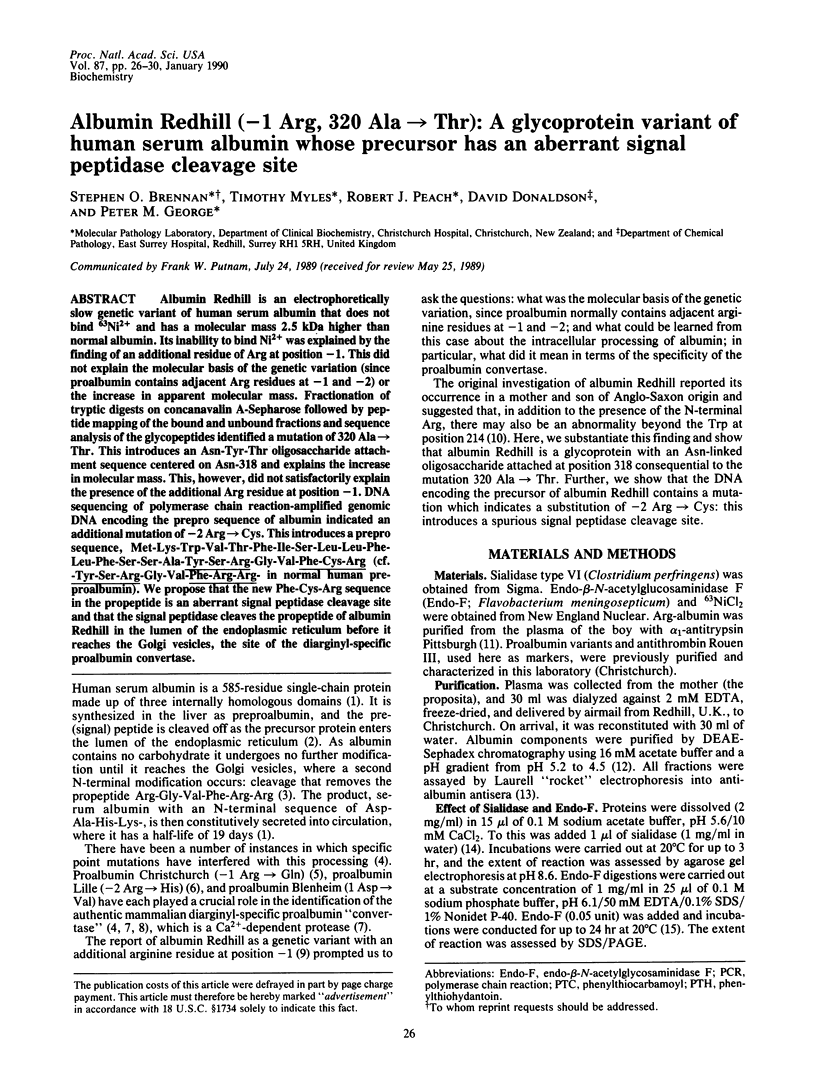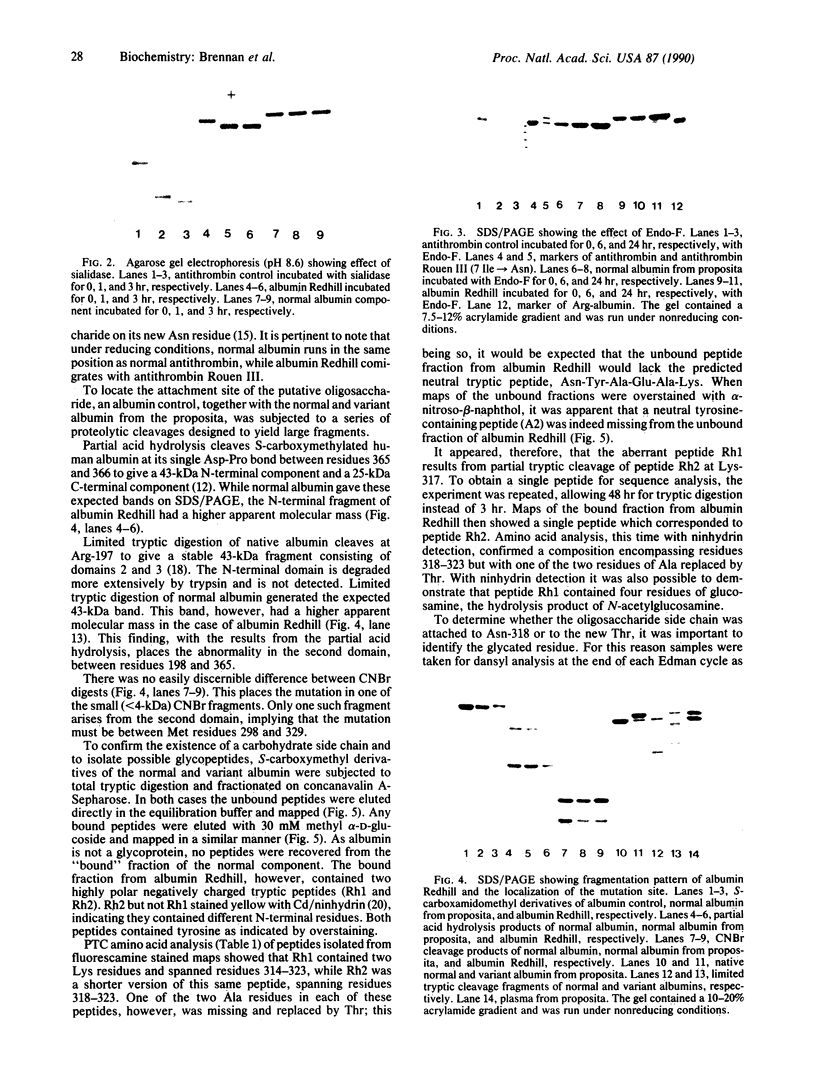Abstract
Albumin Redhill is an electrophoretically slow genetic variant of human serum albumin that does not bind 63Ni2+ and has a molecular mass 2.5 kDa higher than normal albumin. Its inability to bind Ni2+ was explained by the finding of an additional residue of Arg at position -1. This did not explain the molecular basis of the genetic variation (since proalbumin contains adjacent Arg residues at -1 and -2) or the increase in apparent molecular mass. Fractionation of tryptic digests on concanavalin A-Sepharose followed by peptide mapping of the bound and unbound fractions and sequence analysis of the glycopeptides identified a mutation of 320 Ala----Thr. This introduces an Asn-Tyr-Thr oligosaccharide attachment sequence centered on Asn-318 and explains the increase in molecular mass. This, however, did not satisfactorily explain the presence of the additional Arg residue at position -1. DNA sequencing of polymerase chain reaction-amplified genomic DNA encoding the prepro sequence of albumin indicated an additional mutation of -2 Arg----Cys. This introduces a prepro sequence, Met-Lys-Trp-Val-Thr-Phe-Ile-Ser-Leu-Leu-Phe-Leu-Phe-Ser-Ser-Ala-Tyr- Ser-Arg-Gly-Val-Phe-Cys-Arg (cf.-Tyr-Ser-Arg-Gly-Val-Phe-Arg-Arg- in normal human pre-proalbumin). We propose that the new Phe-Cys-Arg sequence in the propeptide is an aberrant signal peptidase cleavage site and that the signal peptidase cleaves the propeptide of albumin Redhill in the lumen of the endoplasmic reticulum before it reaches the Golgi vesicles, the site of the diarginyl-specific proalbumin convertase.
Full text
PDF




Images in this article
Selected References
These references are in PubMed. This may not be the complete list of references from this article.
- ACHER R., CROCKER C. Réactions colorées spécifiques de l'arginine et de la tyrosine réalisées après chromatographie sur papier. Biochim Biophys Acta. 1952 Dec;9(6):704–705. doi: 10.1016/0006-3002(52)90236-9. [DOI] [PubMed] [Google Scholar]
- Abdo Y., Rousseaux J., Dautrevaux M. Proalbumin Lille, a new variant of human serum albumin. FEBS Lett. 1981 Aug 31;131(2):286–288. doi: 10.1016/0014-5793(81)80386-9. [DOI] [PubMed] [Google Scholar]
- Bathurst I. C., Brennan S. O., Carrell R. W., Cousens L. S., Brake A. J., Barr P. J. Yeast KEX2 protease has the properties of a human proalbumin converting enzyme. Science. 1987 Jan 16;235(4786):348–350. doi: 10.1126/science.3541206. [DOI] [PubMed] [Google Scholar]
- Bos O. J., Fischer M. J., Wilting J., Janssen L. H. Drug-binding and other physicochemical properties of a large tryptic and a large peptic fragment of human serum albumin. Biochim Biophys Acta. 1988 Mar 2;953(1):37–47. doi: 10.1016/0167-4838(88)90007-6. [DOI] [PubMed] [Google Scholar]
- Boswell D. R., Jeppsson J. O., Brennan S. O., Carrell R. W. The reactive site of alpha 1-antitrypsin is C-terminal, not N-terminal. Biochim Biophys Acta. 1983 Apr 28;744(2):212–218. doi: 10.1016/0167-4838(83)90093-6. [DOI] [PubMed] [Google Scholar]
- Brand S., Hutchinson D. W., Donaldson D. Albumin Redhill, a human albumin variant. Clin Chim Acta. 1984 Jan 31;136(2-3):197–202. doi: 10.1016/0009-8981(84)90292-4. [DOI] [PubMed] [Google Scholar]
- Brennan S. O. Absolute identification of Hb D-Los Angeles (beta121 Glu replaced by Gln). Hemoglobin. 1977;1(6):571–576. doi: 10.3109/03630267709003421. [DOI] [PubMed] [Google Scholar]
- Brennan S. O., Borg J. Y., George P. M., Soria C., Soria J., Caen J., Carrell R. W. New carbohydrate site in mutant antithrombin (7 Ile----Asn) with decreased heparin affinity. FEBS Lett. 1988 Sep 12;237(1-2):118–122. doi: 10.1016/0014-5793(88)80183-2. [DOI] [PubMed] [Google Scholar]
- Brennan S. O., Carrell R. W. A circulating variant of human proalbumin. Nature. 1978 Aug 31;274(5674):908–909. doi: 10.1038/274908a0. [DOI] [PubMed] [Google Scholar]
- Brennan S. O., George P. M., Jordan R. E. Physiological variant of antithrombin-III lacks carbohydrate sidechain at Asn 135. FEBS Lett. 1987 Jul 27;219(2):431–436. doi: 10.1016/0014-5793(87)80266-1. [DOI] [PubMed] [Google Scholar]
- Brennan S. O., George P. M., Peach R. J. Characterisation of a slow component of normal human serum albumin. Clin Chim Acta. 1988 Aug 31;176(2):179–184. doi: 10.1016/0009-8981(88)90205-7. [DOI] [PubMed] [Google Scholar]
- Brennan S. O., Herbert P. Albumin Canterbury (313 Lys----Asn). A point mutation in the second domain of serum albumin. Biochim Biophys Acta. 1987 Apr 8;912(2):191–197. doi: 10.1016/0167-4838(87)90088-4. [DOI] [PubMed] [Google Scholar]
- Brennan S. O., Jones K. O., Crethar L., Arnold B. J., Fleming P. J., Winterbourn C. C. Haemoglobin North Shore, beta134 Val replaced by Glu, a new unstable haemoglobin. Biochim Biophys Acta. 1977 Oct 26;494(2):403–407. doi: 10.1016/0005-2795(77)90169-6. [DOI] [PubMed] [Google Scholar]
- Brennan S. O., Owen M. C., Boswell D. R., Lewis J. H., Carrell R. W. Circulating proalbumin associated with a variant proteinase inhibitor. Biochim Biophys Acta. 1984 Nov 6;802(1):24–28. doi: 10.1016/0304-4165(84)90029-1. [DOI] [PubMed] [Google Scholar]
- Brennan S. O., Peach R. J. Calcium-dependent KEX2-like protease found in hepatic secretory vesicles converts proalbumin to albumin. FEBS Lett. 1988 Feb 29;229(1):167–170. doi: 10.1016/0014-5793(88)80819-6. [DOI] [PubMed] [Google Scholar]
- Brennan S. O. Propeptide cleavage: evidence from human proalbumins. Mol Biol Med. 1989 Feb;6(1):87–92. [PubMed] [Google Scholar]
- Brennan S. O. The molecular abnormality of albumin Parklands: 365 Asp----His. Biochim Biophys Acta. 1985 Aug 23;830(3):320–324. doi: 10.1016/0167-4838(85)90289-4. [DOI] [PubMed] [Google Scholar]
- Carrell R. W., Bathurst I. C., Brennan S. O. The molecular pathology of human alpha 1-antitrypsin. Biochem Soc Symp. 1984;49:55–66. [PubMed] [Google Scholar]
- Chomczynski P., Qasba P. K. Alkaline transfer of DNA to plastic membrane. Biochem Biophys Res Commun. 1984 Jul 18;122(1):340–344. doi: 10.1016/0006-291x(84)90480-7. [DOI] [PubMed] [Google Scholar]
- Elder J. H., Alexander S. endo-beta-N-acetylglucosaminidase F: endoglycosidase from Flavobacterium meningosepticum that cleaves both high-mannose and complex glycoproteins. Proc Natl Acad Sci U S A. 1982 Aug;79(15):4540–4544. doi: 10.1073/pnas.79.15.4540. [DOI] [PMC free article] [PubMed] [Google Scholar]
- Folz R. J., Gordon J. I. The effects of deleting the propeptide from human preproapolipoprotein A-I on co-translational translocation and signal peptidase processing. J Biol Chem. 1987 Dec 15;262(35):17221–17230. [PubMed] [Google Scholar]
- Folz R. J., Nothwehr S. F., Gordon J. I. Substrate specificity of eukaryotic signal peptidase. Site-saturation mutagenesis at position -1 regulates cleavage between multiple sites in human pre (delta pro) apolipoprotein A-II. J Biol Chem. 1988 Feb 5;263(4):2070–2078. [PubMed] [Google Scholar]
- Gross-Bellard M., Oudet P., Chambon P. Isolation of high-molecular-weight DNA from mammalian cells. Eur J Biochem. 1973 Jul 2;36(1):32–38. doi: 10.1111/j.1432-1033.1973.tb02881.x. [DOI] [PubMed] [Google Scholar]
- Hartley B. S. Strategy and tactics in protein chemistry. Biochem J. 1970 Oct;119(5):805–822. doi: 10.1042/bj1190805f. [DOI] [PMC free article] [PubMed] [Google Scholar]
- Higuchi R., von Beroldingen C. H., Sensabaugh G. F., Erlich H. A. DNA typing from single hairs. Nature. 1988 Apr 7;332(6164):543–546. doi: 10.1038/332543a0. [DOI] [PubMed] [Google Scholar]
- Hutchinson D. W., Matejtschuk P. The N-terminal sequence of albumin Redhill, a variant of human serum albumin. FEBS Lett. 1985 Dec 2;193(2):211–212. doi: 10.1016/0014-5793(85)80153-8. [DOI] [PubMed] [Google Scholar]
- Judah J. D., Quinn P. S. Calcium ion-dependent vesicle fusion in the conversion of proalbumin to albumin. Nature. 1978 Jan 26;271(5643):384–385. doi: 10.1038/271384a0. [DOI] [PubMed] [Google Scholar]
- Laurell C. B. Electroimmuno assay. Scand J Clin Lab Invest Suppl. 1972;124:21–37. doi: 10.3109/00365517209102748. [DOI] [PubMed] [Google Scholar]
- Minghetti P. P., Ruffner D. E., Kuang W. J., Dennison O. E., Hawkins J. W., Beattie W. G., Dugaiczyk A. Molecular structure of the human albumin gene is revealed by nucleotide sequence within q11-22 of chromosome 4. J Biol Chem. 1986 May 25;261(15):6747–6757. [PubMed] [Google Scholar]
- Owen M. C., Brennan S. O., Lewis J. H., Carrell R. W. Mutation of antitrypsin to antithrombin. alpha 1-antitrypsin Pittsburgh (358 Met leads to Arg), a fatal bleeding disorder. N Engl J Med. 1983 Sep 22;309(12):694–698. doi: 10.1056/NEJM198309223091203. [DOI] [PubMed] [Google Scholar]
- Peters T., Jr Intracellular precursor forms of plasma proteins: their functions and possible occurrence in plasma. Clin Chem. 1987 Aug;33(8):1317–1325. [PubMed] [Google Scholar]
- Saiki R. K., Gelfand D. H., Stoffel S., Scharf S. J., Higuchi R., Horn G. T., Mullis K. B., Erlich H. A. Primer-directed enzymatic amplification of DNA with a thermostable DNA polymerase. Science. 1988 Jan 29;239(4839):487–491. doi: 10.1126/science.2448875. [DOI] [PubMed] [Google Scholar]
- Strauss A. W., Bennett C. A., Donohue A. M., Rodkey J. A., Boime I., Alberts A. W. Conversion of rat pre-proalbumin to proalbumin in vitro by ascites membranes. Demonstration by NH2-TERMINAL SEQUENCE ANALYSIS. J Biol Chem. 1978 Sep 10;253(17):6270–6274. [PubMed] [Google Scholar]
- Wong C., Dowling C. E., Saiki R. K., Higuchi R. G., Erlich H. A., Kazazian H. H., Jr Characterization of beta-thalassaemia mutations using direct genomic sequencing of amplified single copy DNA. 1987 Nov 26-Dec 2Nature. 330(6146):384–386. doi: 10.1038/330384a0. [DOI] [PubMed] [Google Scholar]









